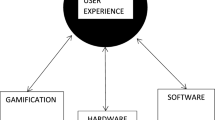Overview
- Authors:
-
-
Alistair Sutcliffe
-
University of Manchester, United Kingdom
Access this book
Other ways to access
About this book
This book explores the design process for user experience and engagement, which expands the traditional concept of usability and utility in design to include aesthetics, fun and excitement. User experience has evolved as a new area of Human Computer Interaction research, motivated by non-work oriented applications such as games, education and emerging interactive Web 2.0. The chapter starts by examining the phenomena of user engagement and experience and setting them in the perspective of cognitive psychology, in particular motivation, emotion and mood. The perspective of aesthetics is expanded towards interaction and engagement to propose design treatments, metaphors, and interactive techniques which can promote user interest, excitement and satisfying experiences. This is followed by reviewing the design process and design treatments which can promote aesthetic perception and engaging interaction. The final part of the chapter provides design guidelines and principles drawn from theinteraction and graphical design literature which are cross-referenced to issues in the design process. Examples of designs and design treatments are given to illustrate principles and advice, accompanied by critical reflection. Table of Contents: Introduction / Psychology of User Engagement / UE Design Process / Design Principles and Guidelines / Perspectives and Conclusions
Similar content being viewed by others
Table of contents (5 chapters)
Authors and Affiliations
-
University of Manchester, United Kingdom
Alistair Sutcliffe
About the author
Alistair Sutcliffe is Professor of Systems Engineering in the Manchester Business School, University of Manchester. He has been principal investigator on fifteen EPSRC and European Union projects on requirements engineering, multimedia user interfaces, safety critical systems and cognitive modelling for information retrieval. Currently funded research projects include EPSRC/ESRC Developing Theory for Evolving Socio-technical Systems (TESS), which is investigating technology-mediated social and work relationships based on Dunbars Social Brain Theory; EPSRC e-Science project ADaptive VISualisation tools for E-Science collaboration (ADVISES), which is producing interactive visualization tools for health informatics researchers; and EPSRC Artificial Cultures, which is researching evolutionary computing simulations for complex socio-technical systems. His research interests span a wide area within human computer interaction and software engineering. In HCI particular interests are interaction theory, and user interface design methods for the web, multimedia, and safety-critical systems; application of cognitive theory to design, and design of complex socio-technical systems. In software engineering, he specializes in requirements engineering methods and tools, scenario-based design, knowledge reuse and theories of domain knowledge. Alistair Sutcliffe is a leading member of both the international HCI and requirements engineering communities. He serves on the editorial boards of ACM-TOCHI, REJ and JASE. He is founder of IFIP TC-13 Working Group 13.2 Methodology for User-Centred Design and a member of IFIP working groups 8.1 (Information Systems) and 2.9 (Requirements Engineering) and is the editor of the ISO standard 14915, on Multimedia user interface design. He has over 200 publications, including five books, and several edited volumes of papers. He was awarded the IFIP Silver Core in 2000.




